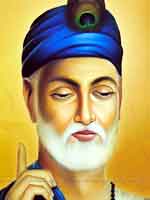Religious Mentors
The river that flows in you also flows in me.

Kabir (Hindi: कबीर, Punjabi: ਕਬੀਰ) (c. 1440 – c. 1518) was a mystic poet and saint of India, whose writings have greatly influenced the Bhakti movement. The name Kabir comes from Arabic al-Kabīr which means "The Great" – the 37th name of God in Islam. Kabir's legacy is today carried forward by the Kabir panth ("Panth of Kabir"), a religious community that recognises him as its founder and is one of the Sant Mat sects. His writings include Bijak, Sakhi Granth, Kabir Granthawali and Anurag Sagar.
Early life and background
According to one traditional version of his parentage, Kabir was born to a Brahmin widow at Lahartara near Kashi (modern day Varanasi). The widow abandoned Kabir to escape dishonour associated with births outside marriage. He was brought up in a family of poor Muslim weavers Niru and Nima. Vaishnava saint Swami Ramananda accepted Kabir as his disciple. When Swami Ramananda died, Kabir was 13 years old.
In his hymns, Kabir does not call himself born as Brahmin, but he refers to himself as born a Julaha many times in his hymns. Bhagat Ravidas, the contemporary of Kabir, also mentioned in his hymn that Kabir was born to Muslims who were cow killers.
According to influential American Indologist Wendy Doniger, Kabir was born into a Muslim family and "all these stories attempt to drag Kabir back over the line from Muslim to Hindu".
Kabir was initiated by Swami Ramananda- a major exponent of Vishishtadvaita philosophy who considered lord Rama as Ista-devata. Kabir too often refers to Rama as his lord. He did not become a sadhu, nor did he entirely abandon worldly life. Kabir chose instead to live the balanced life of a householder and mystic, a tradesman and contemplative. However, there are conflicting views of whether he actually entered into a formal marriage or not.
Kabir's family is believed to have lived in the locality of Kabir Chaura in Varanasi. Kabir maṭha (कबीरमठ), a matha located in the back alleys of Kabir Chaura, celebrates his life and times. Accompanying the property is a house named Nirutila (नीरू टीला) which houses Niru and Nima's graves. The house also accommodates students and scholars who live there and study Kabir's work.
Philosophies
Kabir's legends describe his victory in trials by sultan, a Brahmin, a Qazi, a merchant and God. The ideological messages in Kabir's legends appealed to the poor and oppressed. David Lorenzen describes primary purpose of his legends as a "protest against social discrimination and economic exploitation".
His greatest work is the Bijak (the "Seedling"), an idea of the fundamental one. This collection of poems elucidates Kabir's universal view of spirituality. Though his vocabulary is replete with Hindu spiritual concepts, such as Brahman, karma and reincarnation, he vehemently opposed dogmas, both in Hinduism and in Islam. He often advocated leaving aside the Qur'an and Vedas and simply following Sahaja path, or the Simple/Natural Way to oneness in God. He believed in the Vedantic concept of atman, but unlike earlier orthodox Vedantins, he spurned the Hindu societal caste system and Murti-pujan (idol worship), showing clear belief in both bhakti and Sufi ideas.
Kabir calls his God by the name of Rama. However, his Rama is not the Rama of Ayodhya born of Dashratha. His Rama is Niranjan (without taint), Nirakar (formless) and Nyara (omnipresent, extraordinary). Here, his views are in line with the best ideals exposed in the upanishads.
His Hindi was a vernacular, straightforward kind, much like his philosophies. A major part of Kabir's work as a bhagat was collected by the fifth Sikh guru, Guru Arjan Dev, and incorporated into the Sikh scripture, Guru Granth Sahib. The hallmark of Kabir's works consists of his two line couplets, known as the 'Kabir ke Dohe'.
